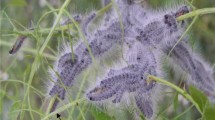Abstract
The impact of herbivores on host plant photosynthetic rates can range from negative to positive. While defoliation by chewing herbivores can result in increases in photosynthesis followed by compensatory growth, other herbivore guilds, such as mesophyll feeders which damage photosynthetic leaf tissues, almost always reduce photosynthetic rates. The impact of galling herbivores on host photosynthesis has rarely been examined, even though the limited tissue disruption and the strong metabolic sinks induced by gall-forming herbivores could potentially stimulate photosynthetic rates. I examined the hypothesis that gall-inducing herbivores could stimulate photosynthesis in neighboring leaves in response to increased sink-demand by the gall. To address this hypothesis, I measured photosynthetic rates of galled leaves or leaflets, neighboring ungalled leaves or leaflets, and ungalled leaves or leaflets on ungalled shoots on naturally growing Prunus serotina (wild cherry) and Rhus glabra (smooth sumac). The leaves of wild cherry were galled by an eriophyid mite, Phytoptus cerasicrumena; the leaves of smooth sumac by an aphid, Melaphis rhois. I found that both species reduced the photosynthetic rates of the leaves or leaflets they galled from 24 to 52% compared to ungalled leaves in ungalled areas of the plants. Contrary to my hypothesis, mite galls on wild cherry reduced photosynthesis of neighboring ungalled leaves within the same shoot by 24% compared to ungalled leaves on gall-free shoots. Aphid galls on sumac leaflets did not significantly alter the photosynthetic rates of neighboring leaflets relative to ungalled leaves on ungalled shoots. Although gall-formers would appear to have the potential to stimulate photosynthesis in the same manner as defoliating herbivores, i.e., by increasing sink demand relative to source supply, I found only negative impacts on photosynthesis. I suggest that sink competition for nutrients between developing leaves and growing gall tissue may account for the negative impacts of sink-inducing gallers on photosynthesis.
Similar content being viewed by others
Author information
Authors and Affiliations
Additional information
Received: 17 October 1997 / Accepted: 2 February 1998
Rights and permissions
About this article
Cite this article
Larson, K. The impact of two gall-forming arthropods on the photosynthetic rates of their hosts. Oecologia 115, 161–166 (1998). https://doi.org/10.1007/s004420050503
Issue Date:
DOI: https://doi.org/10.1007/s004420050503




